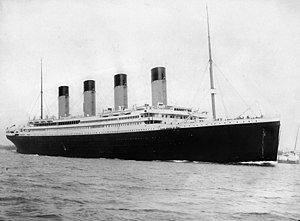
The RMS Titanic
The ship of dreams. The unsinkable diamond. The resplendent wonder. An array of names have described the RMS Titanic, one of the world’s earliest engineering challenges and a true modern wonder of the early 1900s. With a full capacity of over 3,500 passengers and over 1,000 crew men, the Titanic was easily the largest ship on the seas at that time, and even today takes top spot as the most luxurious and splendor-filled ship of all times. Built by the White Star Line, which had envisioned the Titanic as the “last word on luxury”, the ship took over four years of non-stop toil to construct and set new records for construction size.
The expense of the Titanic is absolutely staggering. Adjusted for inflation, the ship would have required tens of billions of dollars to construct, and no points for guessing that advancements in technology would push up costs even further. Designed by Harland and Wolff’s Thomas Andrews, the Titanic was actually born out of a commercial war: basically built to put the White Star Line back into the top of the game, after increasing losses to Cunard. The ship’s construction faced a number of delays and witnessed many unfortunate deaths of workers, who dubbed the Titanic as “the black death”.

The world-famous Grand Staircase of the RMS Titanic
The modernity of the ship, as well as its quaint and grand feel, is often remarked upon throughout history. The now-famed Grand Staircase is considered a sea-based architectural wonder in itself. The machinery and running of the ship was based on the latest technology mankind had invented, including superfast Marconi radios and an all-updated gymnasium. Alas, despite all the modernity, the Titanic followed rather ancient sea-faring laws. Today its no secret that the Titanic suffered from a crippling shortage of lifeboats, a fact which – rectified – could have saved innumerable lives. Besides this, the ship’s propeller system, despite advanced, faced old control manuals.
The RMS Titanic set sail on its maiden (and ultimately final) voyage on April 10, 1912, intending to go around Britain, France and finally to New York in the USA.

Map of Titanic's voyage
There were over 2,200 passengers on board, all unaware of the disaster to strike; enveloped in the serenity of the supposed “unsinkability” of the ship, they ventured on, not knowing of the perils of the cold season of the Atlantic. A number of factors that, if rectified, could have saved the ship: earlier completion of construction, and many many more. But none happened, and the Titanic rammed into a massive iceberg, causing major rips in the ship’s hull. It took just over two hours to sink a four-year masterpiece, a cruel irony of nature. The now-well known snapping of the Titanic into two pieces is often regarded with great awe and fear, though it was properly captured only recently. Over 1,500 lives were lost in the catastrophe, which would easily rank as one of the biggest man-based disaster ever. For months, chaos and investigations continued, and enormous losses to adjoining companies (especially insurance companies) and loss of bread-earners created a huge dent in the economies. Such an incident has, thankfully, not been repeated. Yet.
FILM
Much more about the ship and its wreck is known today, despite the fact that for many years, the Titanic’s sinking had been forgotten. Massive interest in the wreck was sparked off by the release of James Cameron’s epic Titanic, co-produced by Paramount Pictures and 20th Century Fox, which is today considered one of the greatest films of all times.
Titanic, the motion picture
The raw power of the sinking, and the unforgettable ship itself, have since then occupied a perennial place in the peoples’ minds, and Titanic has never once left conversations. To commemorate the 100 years of sinking of this great wonder, Titanic was re-released in 3D on April 4, 2012 to an excellent response. The world over has since been commemorating Titanic in their own ways, be it silence or a number of memorials, cards and other symbolic gestures to the tragedy.
For a nation as captivated with Titanic as us, it would be blasphemy to forget this event. For a few moments, it is better to keep aside all else and just wonder at this ship: what it was, and what it could have been.







